Resources
This page contains some key resources on walking and cycling, including an archive of the documents produced by the Australian Bicycle Council.
| Date Added | |||
|---|---|---|---|
 |
Tasmanian Walk, Wheel, Ride Policy Department of State Growth, Tasmania This policy updates the Positive Provision Policy for Cycling Infrastructure. The 2013 policy aimed to inform State Government decision-making in relation to investment in cycling infrastructure, particularly in the planning and design of new roads and road upgrades.
|
12/08/2024 | View |
 |
Safer cycling infrastructure: Design and policy Transport for NSW iMOVE’s Safer cycling and street design: A guide for policymakers project was a two-year investigation with Transport for NSW (TfNSW) and the University of NSW on how to best integrate cycling into urban and suburban environments in order to interest more people in that mode of transport, addressing their concerns about safety. |
22/07/2024 | View |
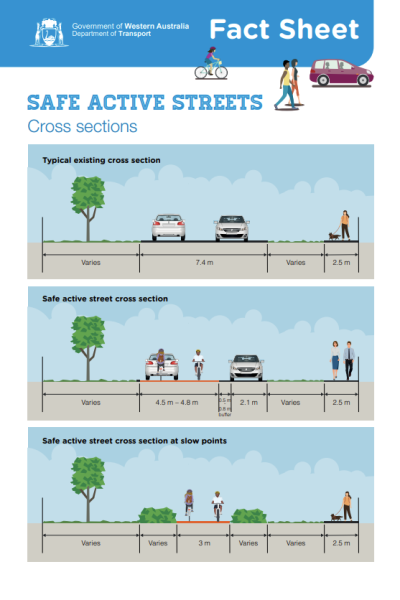 |
Safe Active Streets Pilot Program Department of Transport WA Department of Transport WA has been working with Western Australian local governments to develop, trial and evaluate ‘safe active streets’ which use local area traffic management treatments to encourage more people to walk, wheel and ride in their communities. |
18/03/2024 | View |
 |
Active Travel Plan and Design Guide ACT Government This Plan outlines ACT Government priorities for strengthening active travel and improving quality of life. Projects included throughout demonstrate what these priorities mean in practice. |
01/03/2024 | View |
 |
Planning and designing for active transport Department of Transport Western Australia Collaborating with and guiding state and local government and industry partners to plan, design and develop active transport solutions to help make it an easy choice for people of all ages and abilities to walk, wheel and ride. |
02/02/2024 | View |
 |
Northern Territory shared path network reviews Department of Infrastructure, Planning and Logistics (DIPL), Northern Territory The Department of Infrastructure, Planning and Logistics (DIPL) has completed a review of Northern Territory Government (NTG) owned shared paths across Greater Darwin, Katherine, Tennant Creek and Alice Springs. The review is key to continuing strategic development of shared paths in line with stakeholder and community needs for the next 10 years. The purpose of the review was to assess the existing NTG shared path networks and provide recommendations for:
A number of key considerations guided the review including efficiency, safety and connectivity. |
11/12/2023 | View |
 |
Australian Transport Assessment and Planning (ATAP) Mode Specific Guidance: M4 Active Travel Australian Transport Assessment and Planning (ATAP) At a glance:
|
13/11/2023 | View |
 |
Promotion, encouragement and behaviour change Department of Transport and Main Roads, Queensland On this page: |
27/10/2023 | View |
 |
Paths for walking Department of Transport and Main Roads, Queensland On this page |
27/10/2023 | View |
 |
Construction and maintenance Department of Transport and Main Roads, Queensland On this page: |
27/10/2023 | View |
 |
Shade and street trees Department of Transport and Main Roads, Queensland On this page: |
27/10/2023 | View |
 |
Pedestrian and Walking Guidance: Supporting facilities Department of transport and Main Roads, Queensland On this page: |
27/10/2023 | View |
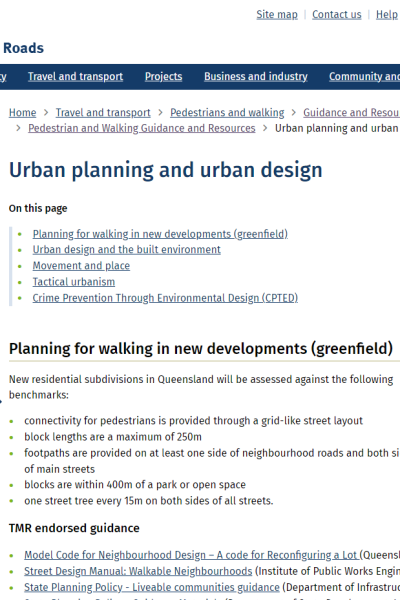 |
Urban planning and urban design Department of Transport and Main Roads, Queensland On this page: |
27/10/2023 | View |
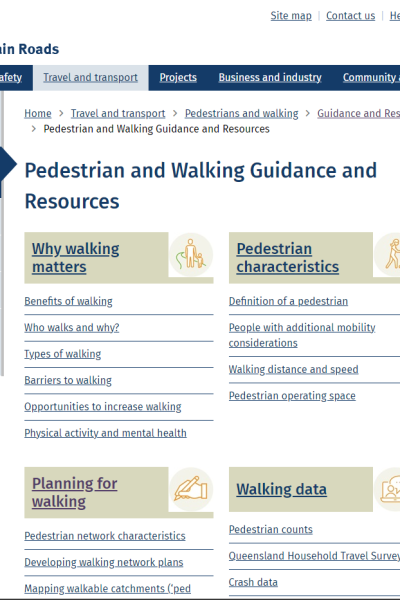 |
Pedestrian and Walking Guidance and Resources Department of Transport and Main Roads, Queensland Including:
|
13/10/2023 | View |
 |
Walking Network Planning Guidance Department of Transport and Main Roads, Queensland More people will walk when everyday destinations are connected by comfortable, direct, safe and accessible routes. Walking network plans (WNPs) are a first step to creating better places to walk. The Queensland Government is committed to achieving the Queensland Walking Strategy 2019–2029 vision of walking becoming 'an easy choice for everyone, every day'. When we talk about walking, we also include running and moving with the help of a mobility device (such as a wheelchair, mobility cane or a walking frame). The following guidance supports practitioners to prepare WNPs and a prioritised works program to make the plan a reality. |
13/10/2023 | View |
 |
Active Travel to Schools Programs CWANZ An overview of active travel to schools programs across Australia and New Zealand, their key features and what makes them successful. Also includes a comparison of the number of children that use active travel to school from around the world. |
23/08/2023 | View |
 |
Movement Strategy City of Darwin The Movement Strategy aims to make it easier for all people to move around our suburbs and city by improving streetscapes, infrastructure and connectivity while reducing the impact of transport on the environment. The Movement Strategy creates a framework and direction to align investment and policy decisions with the aspirations of the community. |
02/06/2023 | View |
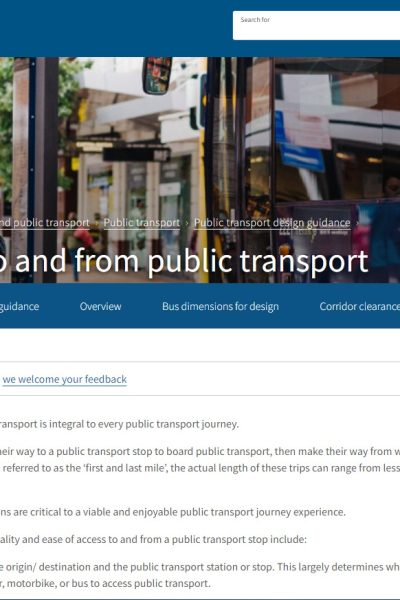 |
Getting to and from public transport Waka Kotahi NZ Transport Agency Getting to and from public transport is integral to every public transport journey. All passengers must make their way to a public transport stop to board public transport, then make their way from where they disembark to their final destination. Often referred to as the ‘first and last mile’, the actual length of these trips can range from less than 100m to many kilometres. First and last mile connections are critical to a viable and enjoyable public transport journey experience. Key issues relating to the quality and ease of access to and from a public transport stop include:
It is important that those involved in public transport planning consider the whole of the passengers' journey. When planning for public transport journeys, the following questions should be considered:
|
19/05/2023 | View |
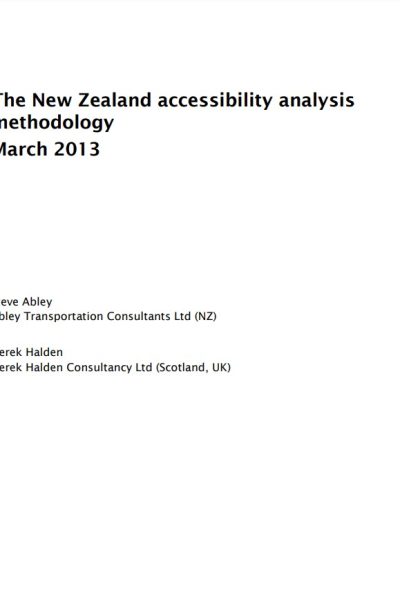 |
Research Report 512 The New Zealand accessibility analysis methodology Waka Kotahi NZ Transport Agency This research considers land use and transport accessibility drawing on international practice from the UK, Europe, USA and Australia. An objective of the research was to define accessibility and propose a methodology for how accessibility could be measured and quantified in New Zealand, both at a neighbourhood or a wider area such as a suburb, city or region. The result of the research was an understanding of other countries’ experiences developing and setting accessibility policy and the success of those approaches. This is important because if New Zealand chooses to set explicit accessibility policy, the research explains how that might be best achieved. A second result of the research was the development of a new methodology for calculating accessibility that draws on overseas and improved practice. The new methodology quantitatively measures accessibility taking into consideration different modes of travel (walk, cycle, private motor vehicle etc), travel behaviour (ideally using logistic decay functions), destinations (origin or destination based), activities (consumed or supplied) and multiple opportunities (saturations). The calculation methodology was piloted on Christchurch (a city of some 350,000 people) and the accessibility of every household quantified to a variety of destinations including doctors, supermarkets and schools. Keywords: accessibility, cycling, GIS, indicators, journey planning, methodology, modelling, networks, New Zealand, public transport, transport, walking |
19/05/2023 | View |
 |
40 km/h speed limits in high volume pedestrian areas Transport for NSW A guide to identifying and implementing 40 km/h speed limits in high volume pedestrian areas. |
15/05/2023 | View |
 |
Personal mobility device plans Deaprtment of Transport and Main Roads, Queensland Personal mobility devices include things like e-scooters, e-skateboards and self-balancing one or two-wheelers. The recent boom in the use of personal mobility devices has created some safety issues as riders share a range of infrastructure with other road and path users. Shared e-scooter and e-bike hire schemes have also become commonplace across Queensland. While these schemes are a great mobility option, they have created some problems with parking on footpaths. To address safety and parking concerns Deaprtment of Transport and Main Roads, Queensland are delivering:
|
01/05/2023 | View |
 |
Personal mobility devices Department of Transport and Main Roads, Queensland Know your way around Personal Mobility Devices such as e-scooters, e-skateboards and segways.
|
01/05/2023 | View |
 |
Get NSW Active Transport for NSW The Get NSW Active program provides local councils with funding for projects that create safe, easy and enjoyable walking and cycling trips. These trips help to relieve pressure on our roads and public transport networks and are part of a healthy lifestyle for NSW communities. |
01/05/2023 | View |
 |
Bike-friendly business Department of Transport and Main Roads, Queensland Bike riders are customers who choose to arrive by bike. There’s a big opportunity for businesses to achieve growth by becoming bike-friendly. More than ever, bike riders want to go from A to Business. There’s growing demand to stop, shop and spend at bike-friendly businesses of all different types, from local cafes right through to tourism destinations. Being bike-friendly can be a point of difference for a business. It means the business can offer more customers more choice and freedom. |
06/04/2023 | View |
 |
Safe Active Streets Pilot Program Evaluation Department of Transport WA The Safe Active Street (SAS) Program’s vision is to create shared street spaces that provide a convenient travel option within a safe and attractive environment for people riding and walking of all ages and abilities. To achieve the vision of the SAS Program the following objectives have been established:
The SAS Pilot Program is being evaluated in line with DoT’s SAS Pilot Program Evaluation Plan, which has adopted a summative evaluation framework that considers impacts, cost effectiveness and comparability between projects. The SAS Pilot Program Evaluation Plan clearly details in an Outcomes Measurement Framework the specific indicators, targets, and data sources to adequately evaluate the program. |
05/04/2023 | View |
 |
Active Travel to School Roadmap 2023-2030 Department of Transport WA The Active Travel to School Roadmap aims to reverse the declining rate of walking and cycling to school in Perth. Containing 24 initiatives, the Roadmap seeks to address key urban planning, policy, individual and social factors, and enable more children to walk, bike ride, scoot and catch public transport to school. The Roadmap was developed by a dedicated Active Travel to School Working Group, which was established by the Bicycle Riding Reference Group, and has been endorsed by the Departments of Transport, Education and Health, the Road Safety Commission, the Western Australian Local Government Association and the Institute of Public Works and Engineering Australasia. Delivery of the Roadmap will commence in 2023 and progress will be reported to the Bicycle Riding Reference Group. |
21/03/2023 | View |
 |
Active Travel to School: Ride or Walk to School (Safe Cycle) Transport Canberra and City Services PROGRAM FEATURES:
DATE IMPLEMENTED: 1 December 2012 COST OF PROGRAM: $75,000 per year COST FOR USERS: Free ADDITIONAL INFORMATION: The Ride or Walk to School program (primary) and It's Your Move Safe Cycle program (high school) provides ACT schools with safe cycling resources. It is aligned to the Australian curriculum and includes teacher training and information for parents. The aim is to increase the number of children walking and riding to and from school. Part of program incorporating infrastructure, signage (Active Streets), and safety at school crossings (School Crossing Supervisors) to encourage children to use active travel to get to and from school. RESULTS OF EVALUATION: |
14/03/2023 | View |
 |
Active Travel to School Program: School Transport Infrastructure Program Department of Transport and Main Roads, Queensland PROGRAM FEATURES: Funding to improve the safety and operation of schools through new or improved infrastructure at the school and/or on the surrounding road network. E.g.:
DATE IMPLEMENTED: Not available COST OF PROGRAM: Not available. Grants up to $500,000 available COST TO USER: Funding usually provided on a 50:50 subsidy basis, e.g. co-funding between Department of Transport and Main Roads and local government RESULTS OF EVALUATION: Not available |
28/02/2023 | View |
 |
Active Travel to School Program: Walk to School City of Whittlesea PROGRAM FEATURES:
DATE IMPLEMENTED: Not available COST: Not available |
14/02/2023 | View |
 |
Active Travel to School Program: Stroll & Roll Latrobe City Council PROGRAM FEATURES:
DATE IMPLEMENTED: 30 January 2022 COST OF PROGRAM: Not available COST FOR USERS: None RESULTS OF EVALUATION: Not available |
14/02/2023 | View |
 |
Active Travel to School Program: Safe Routes to School Program WestCycle PROGRAM FEATURES: Part of Bike Friendly Schools Program DATE IMPLEMENTED: Not available COST: Not available RESULTS OF EVALUATION: Not available |
30/01/2023 | View |
 |
Active Travel to School Program: Whittlesea Active Travel in Schools City of Whittlesea PROGRAM FEATURES:
DATE IMPLEMENTED: 2013 COST: Not available RESULTS OF EVALUATION: Not available |
30/01/2023 | View |
 |
Active Travel to School Program: Port Sorell Primary School - Active Travel to School Port Sorell Primary School PROGRAM FEATURES:
DATE IMPLEMENTED: 2013 COST: Not available RESULTS OF EVALUATION: Not available |
30/01/2023 | View |
 |
Active Travel to School Program: Ipswich Healthy Active School Travel City of Ipswich PROGRAM FEATURES:
DATE IMPLEMENTED: Not available COST: Not available RESULTS OF EVALUATION: Not available |
30/01/2023 | View |
 |
Active Travel to School Program: Active School Travel, Sunshine Coast Council Sunshine Coast Council PROGRAM FEATURES:
DATE IMPLEMENTED: Not available COST: Not available RESULTS OF EVALUATION: Not available |
30/01/2023 | View |
 |
Active Travel to School Program: Your Move Schools Department of Transport, WA PROGRAM FEATURES:
DATE IMPLEMENTED: 2017 COST OF PROGRAM: Not available COST FOR USERS: None RESULTS OF EVALUATION: Not available |
30/01/2023 | View |
 |
Active Travel to School Program: The Healthy Schools Achievement Program Cancer Council Victoria PROGRAM FEATURES:
DATE IMPLEMENTED: Not available COST: Not available. Free for schools. RESULTS OF EVALUATION: Not available |
30/01/2023 | View |
 |
Active Travel to School Program: Move Well, Eat Well (Stride and Ride) Department of Health, Tasmania PROGRAM FEATURES: Stride and Ride:
DATE IMPLEMENTED: Not available COST OF PROGRAM: Not available COST FOR USERS: None RESULTS OF EVALUATION: Not available |
30/01/2023 | View |
 |
Active Travel to School Program: Way2Go Bike Ed Department for Infrastructure and Transport, South Australia PROGRAM FEATURES:
DATE IMPLEMENTED:
COST OF PROGRAM: Not available COST FOR USERS: Free for schools RESULTS OF EVALUATION: Report |
30/01/2023 | View |
 |
Active Travel to School Program: Way2Go Department for Infrastructure and Transport, South Australia PROGRAM FEATURES:
DATE IMPLEMENTED: Commenced in 2005 as Safe Routes to School, re-branded to Way2Go in 2009 COST OF PROGRAM: Not available COST FOR USERS: Free for schools RESULTS OF EVALUATION: Not available |
30/01/2023 | View |
 |
Active Travel to School Program: Go Noosa Schools Noosa Council PROGRAM FEATURES:
DATE IMPLEMENTED: Not available COST: Not available RESULTS OF EVALUATION: Not available |
30/01/2023 | View |
 |
Active Travel to School Program: Active School Travel, City of Gold Coast City of Gold Coast PROGRAM FEATURES: Schools that join the program receive a suite of resources including free toolkits, incentives and support. Including:
Educational programs:
DATE IMPLEMENTED: Not available COST: Not available RESULTS OF EVALUATION: Not available |
30/01/2023 | View |
 |
Active Travel to School Program: Active School Travel Program, Brisbane City Council Brisbane City Council PROGRAM FEATURES: The Active School Travel (AST) program offers Brisbane primary schools a suite of free resources, tools and incentives to enable students, parents, carers and teachers to leave the car at home and actively travel to school. Participating schools will receive access resources, including:
Other resources:
DATE IMPLEMENTED: 2004 COST OF PROGRAM: FY 2022-23 $699,000 COST FOR USERS: Free for schools. RESULTS OF EVALUATION: Since 2004, 168 schools and more than 127,000 students have participated in the program. Achievements in 2021:
Approximately 90% of AST committee members agreed the AST program helped to increase student physical activity levels and foster community cohesion at their school. |
30/01/2023 | View |
 |
Active Travel to School Program: Active School Travel, Bicycle Queensland Bicycle Queensland PROGRAM FEATURES: Resources for schools:
Online resouces:
DATE IMPLEMENTED: 2021 COST OF PROGRAM: Not available. Funding provided by community road safety program COST TO USERS: None RESULTS OF EVALUATION: Not available |
17/01/2023 | View |
 |
Active Travel to School Program: Darwin Safe and Active Routes to School Tool Kit City of Darwin PROGRAM FEATURES: A toolkit that provides a step by step approach for schools to create a program and activity for schools and families to promote active travel to school. The toolkit is divided into the following categories:
DATE IMPLEMENTED: August 2016 COST OF PROGRAM: Not available COST TO USER: None ADDITIONAL INFORMATION: Other resources available are:
RESULTS OF EVALUATION: Not available |
17/01/2023 | View |
 |
Active Travel to School Program: Switch it Up NSW Education PROGRAM FEATURES:
DATE IMPLEMENTED: Not available COST: Not available RESULTS OF EVALUATION: Not available |
17/01/2023 | View |
 |
Active Travel to School Program: BikeReady (NSW) NSW Health PROGRAM FEATURES: Resource to support communities and schools to encourage more young people to walk or cycle, and to involve young people in the development and implementation of an active travel initiative. Includes:
DATE IMPLEMENTED: Not available COST: Not available RESULTS OF EVALUATION: Not available |
17/01/2023 | View |
 |
Active Travel to School: Bikes in Schools Waka Kotahi New Zealand Transport Agency PROGRAM FEATURES: A typical Bikes in Schools package includes:
Online resources also available, including bike games. DATE IMPLEMENTED: Not available COST: Not available ADDITIONAL INFORMATION: Part of program that also includes BikeReady RESULTS OF EVALUATION: Not available |
17/01/2023 | View |
 |
Active Travel to School Program: BikeReady (NZ) Waka Kotahi New Zealand Transport Agency PROGRAM FEATURES:
DATE IMPLEMENTED: Not available COST: Not available ADDITIONAL INFORMATION: Part of program that also includes Bikes in Schools RESULTS OF EVALUATION: Not available |
17/01/2023 | View |
 |
Active Travel to School Program: Bikes for Schools AusCycling PROGRAM FEATURES:
DATE IMPLEMENTED: Not available COST: Not available ADDITIONAL INFORMATION: Ride Nation funds:
Plus they:
RESULTS OF EVALUATION: Not available |
16/01/2023 | View |
 |
Active Travel to School Program: Ride Nation Schools AusCycling PROGRAM FEATURES: Ride Nation Schools is a learn-to-ride Bike Education Program delivered in schools Australia-wide. It is a fun and interactive learning experience that teaches young people to develop their riding skills and confidence – supporting kids in their independence and giving parents peace of mind. DATE IMPLEMENTED: Not available COST: Not available ADDITIONAL INFORMATION: There are three levels of bike education programs in schools: Ride Nation - Skills (Playground): Recommended for grades 2-3, this 4–6-week program focuses on developing the essential bike control skills braking, balancing and riding. The skills learnt in this program will allow them to ride around in traffic free environments (school yard, park and around the block). Ride Nation - Confidence (Pathways): Recommended for grades 3-5. Once grasping the essential bike control skills, participants are ready to develop their riding confidence. This 4-6-week program focuses on riding and situational awareness, providing students with the skills and competences to enable them to start riding on footpaths and shared pathway in low traffic environments. This program is ideal to start having students riding to and from school! Ride Nation - Explore (Places): Recommended for grades 5-6. Looks at utilising all the skills learnt through previous programs and develop them in different cycling situations and explore their local area by developing road safety and situational awareness. The program consists of four weeks of practical skill development and learning and ends with two local community rides for children to understand what is in their community. RESULTS OF EVALUATION: Not available |
16/01/2023 | View |
 |
Active Travel to School Program: RideScore We Ride Australia PROGRAM FEATURES: RideScore Active Schools uses technology to direct message parents when their children have arrived safely at school. The program uses:
DATE IMPLEMENTED: November 219 COST: Not available ADDITIONAL INFORMATION: RESULTS OF EVALUATION: In progress |
16/01/2023 | View |
 |
Active Travel to School Program: Open Streets Bicycle Network PROGRAM FEATURES:
DATE IMPLEMENTED: Not available COST: Not available ADDITIONAL INFORMATION: Part of suite of programs to help break down the barriers that prevent more students from staying active on their journey to school. Culminates in National Ride2School Day. RESULTS OF EVALUATION: Not available |
16/01/2023 | View |
 |
Active Travel to School Program: Ride2School Bicycle Network PROGRAM FEATURES:
DATE IMPLEMENTED: Not available COST: Not available ADDITIONAL INFORMATION: Suite of programs to help break down the barriers that prevent more students from staying active on their journey to school. Culminates in National Ride2School Day. RESULTS OF EVALUATION: Not available |
09/01/2023 | View |
 |
Active Travel to School Program: School Crossing Supervisors Transport Canberra and City Services PROGRAM FEATURES: School crossing supervisors (lollipop people) to assist children to cross roads safely by directing traffic with a stop sign and providing instructions. They also help to manage the flow of pedestrians and motorists at the busiest crossings. DATE IMPLEMENTED: 1 January 2018 COST OF PROGRAM: $700,000 per year COST FOR USERS: None ADDITIONAL INFORMATION: Part of program incorporating infrastructure, signage (Active Streets), training and other resources (Ride or Walk to School) to encourage children to use active travel to get to and from school. RESULTS OF EVALUATION: Not available |
09/01/2023 | View |
 |
Active Transport Strategy Transport for NSW The NSW Government wants walking and bike riding, known as active transport, to be the preferred way to make short trips and a viable, safe and efficient option for longer trips. We estimate that more than 1.5 billion walking and bike riding trips are taken per year across New South Wales. We want to double this number in 20 years. NSW Government’s Future Transport Strategy sets the vision for safe, healthy, sustainable, accessible and integrated journeys in NSW. This Active Transport Strategy draws on the Future Transport Strategy and its vision for walking, bike riding and personal mobility. The Strategy provides a plan to guide planning, investment and priority actions for active transport across NSW. |
16/12/2022 | View |
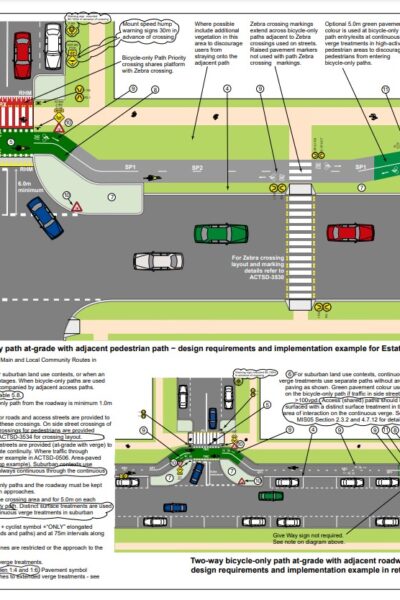 |
Municipal Design Standard Drawings Transport Canberra City Services The ACT Standard Drawings support the Municipal Infrastructure Design Standards and Technical Specifications. The Standard Drawings have been designed to be read in conjunction with the relevant referenced Municipal Infrastructure Standards (MIS) and Municipal Infrastructure Technical Specifications (MITS). The Standard Drawings provide detailed pictorial guidance for ACT civil assets, and reflects the most up-to-date industry practice. The design of and construction of municipal assets in the ACT must be in accordance with the Municipal Infrastructure Design Standards and Technical Specifications. Where any differences in practice exist between the Standard Drawings and the Municipal Infrastructure Standard, the later will prevail. |
08/07/2022 | View |
 |
Road Planning and Design Manual Department of Transport and Main Roads, Queensland The Road Planning and Design Manual is the Queensland Department of Transport and Main Roads' primary reference for the planning and design of roads. It refers designers to the relevant Austroads publications for technical requirements, and outlines where Queensland Department of Transport and Main Roads practice supplements or differs from the Austroads guides. |
08/07/2022 | View |
 |
Municipal Infrastructure Design Standards (MIS) Transport Canberra City Services The Municipal Infrastructure Standards (MIS) utilise the AusSpec document framework. This framework provides a level of design consistency across all local government jurisdictions in Australia, and reflects the most up-to-date industry practice. A number of local and regional government jurisdictions have adopted the AusSpec document framework as the primary technical framework for their design standards. |
08/07/2022 | View |
 |
CWANZ Fact Sheet: Safety CWANZ Research has repeatedly shown that the more people walking or riding a bike, the safer it is for everyone. Reducing the number of cars and speed limits in built-up areas reduces the risk of death or injury to our most vulnerable road users. Growth in cycling is best achieved through separated cycle lanes and reduced speed limits. |
28/04/2022 | View |
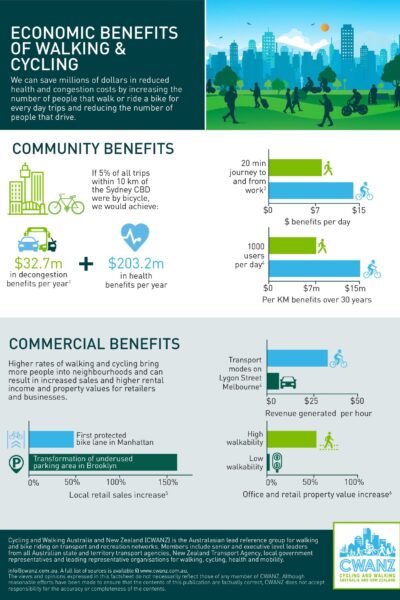 |
CWANZ Fact Sheet: Economic Benefits of Walking & Cycling CWANZ We can save millions of dollars in reduced health and congestion costs by increasing the number of people that walk or ride a bike for every day trips and reducing the number of people that drive. |
19/04/2022 | View |
 |
CWANZ Fact Sheet: Benefits of Lower Speed Limits CWANZ Benefits of lower speed limits in high activity areas and local access streets. What happens when vehicles travel more slowly in areas with lots of pedestrians and bike riders? |
19/04/2022 | View |
 |
CWANZ Fact Sheet: Health Benefits of Active Transport CWANZ Physical inactivity is one of the top 10 risk factors contributing to disease in Australia, contributing to 2.5% of the total burden of disease and is the 5th highest behavioural risk factor, behind tobacco use, diet, alcohol and illicit drug use. |
19/04/2022 | View |
 |
CWANZ Fact Sheet: Costs of Transport and Physical Inactivity CWANZ Congestion costs, transport costs and healthcare costs of physical inactivity. |
13/04/2022 | View |
 |
Cycling Propensity Transport for NSW This dataset contains the propensity index for cycling across different areas. It also contains the report that examines spatial relationship between areas with high propensity for cycling with high concentrations of short distance car trips. |
12/04/2022 | View |
 |
Active Transport to School Transport for NSW |
12/04/2022 | View |
 |
Bike Law Amy Gillett Foundation A bike rider’s guide to road rules in Victoria. This guide outlines the essential road rules you need to know as a bike rider. |
12/04/2022 | View |
 |
Travel planning toolkit guidelines and resources Waka Kotahi NZ Transport Agency The Waka Kotahi NZ Transport Agency travel planning toolkit provides you with guidelines and resources to make business trips and staff travel to and from work more efficient. You will find links to many resources to help you develop your workplace travel plan. |
07/04/2022 | View |
 |
Research Report 439 Generation of walking, cycling and public transport trips: pilot study Waka Kotahi NZ Transport Agency This research investigated a method for collecting data relating to walk, cycle and public transport trips to land-use activities. A method needed to be developed that would require a short questionnaire to ensure higher sample rates, while also providing reliable and consistent results. This data could subsequently be used in calculating trip rates for walk, cycle and public transport trips, when combined with trip rate units such as floor area. Multi-modal trip data has been collected for some time in the UK. The survey method developed in this research was simpler than the UK method by interviewing in only one direction for the vast majority of land uses, apart from residential where the recommended method was to interview in both directions. A face-to-face questionnaire method was developed over a series of different site surveys in Auckland, Wellington and Christchurch during 2010. The research also identified that collecting non-car mode trip information through purely observer methods was not sufficiently accurate and that simple questionnaire surveys were necessary with clear instructions from the survey organiser to ensure all relevant information would be collected. |
07/04/2022 | View |
 |
Research Report 435 Walking and cycling: improving combined use of physical activity/health and transport data Waka Kotahi NZ Transport Agency SPARC's Active New Zealand Survey (ANZS) is a high-quality nationwide survey of over 4000 adults collected through face-to-face interviews over 12 months in 2007/08. Although collected mainly to measure levels of sport/recreation activity and to quantify physical activity in general, it includes data of interest to the transport sector on walking and cycling.
|
07/04/2022 | View |
 |
Research Report 359 Valuing the health benefits of active modes Waka Kotahi NZ Transport Agency This report seeks to provide a per-kilometre value for the health benefits of active transport modes (such as walking and cycling) that is compatible with the Land Transport New Zealand Economic Evaluation Manual Volume 2 (EEM2). The first two sections of the report begin by explaining the scope of the project and the background. Section 3 investigates the evidence of the connection between physical activity and health outcomes. Section 4 clarifies the role of active transport modes as physical activity, and reports the New Zealand-specific data about active transport mode engagement. Section 5 gives a brief comparative summary of the literature review of cost-benefit analyses and valuation techniques used overseas to value the health benefits of active modes. This report uses population attributable fractions (PAF) to estimate the annual burden of mortality and morbidity costs per inactive adult. Annual estimates of the costs of inactivity are applied to the New Zealand adult population using a weighted sum to establish a per-kilometre value for each mode. The valuation presented in this report is limited by a poverty of data, but the final values are considered to be a reasonable estimate of the health benefits of active modes. While further research is recommended to obtain more precise estimates of the costs of inactivity in New Zealand, it is considered that the values presented in this report are a sound interim estimate for inclusion in the EEM2. |
07/04/2022 | View |
 |
Research Report 294 Increasing cycling and walking: an analysis of readiness to change Waka Kotahi NZ Transport Agency In 2003, Sport and Recreation New Zealand (SPARC) and the Cancer Society of New Zealand commissioned a major social marketing survey to segment adult New Zealanders in terms of physical activity and healthy eating habits. The questionnaire included several transport-related questions. The resulting ‘Obstacles to Action’ database contains responses from over 8000 people aged 16 or over. |
07/04/2022 | View |
 |
Low-powered Vehicles Waka Kotahi NZ Transport Agency There is a range of low-powered devices that New Zealanders use for travel or recreation. While these vehicles and devices offer the benefit of increased mobility, they can also increase your safety risks on and around the road. |
19/10/2021 | View |
 |
Shared and Separated Path Guidelines Department of Transport WA This document provides practitioners with guidance surrounding the planning and design of shared and separated paths in Western Australia to enable the safe and efficient movement of bicycle riders of all ages and abilities. It is intended to be a convenient and practical reference guide aimed at practitioners with varying levels of experience. |
06/10/2021 | View |
 |
Design Guidance for Pedestrian and Cycle Rail Crossings Waka Kotahi NZ Transport Agency Waka Kotahi NZ Transport Agency and KiwiRail have been leading the development of a design guide for pedestrian and cycleway treatment at level crossings. The guide will improve safety, usability, compliance, consistency and will simplify the design process. |
21/09/2021 | View |
 |
Research Report 660: Factors affecting cycling levels of service Waka Kotahi NZ Transport Agency This report examines cyclists’ perceptions of cycle infrastructure levels of service and proposes an assessment methodology for evaluating the level of service provided by cycling facilities. |
03/09/2021 | View |
 |
Future Transport Transport for NSW Future Transport sets the direction for connecting people, communities and businesses in NSW to provide a successful and thriving future. |
03/08/2021 | View |
 |
Tasmanian Walking and Cycling for Active Transport Strategy Department of State Growth The Tasmanian Walking and Cycling for Active Transport Strategy is a key component of the Tasmanian Urban Passenger Transport Framework, which aims to promote walking and cycling as viable and desirable forms of transport through improved infrastructure, land use planning and behavioural change. The Strategy is intended to guide development of walking and cycling as transport options in our urban areas over the long-term by creating a more supportive transport system for pedestrians and cyclists. |
30/07/2021 | View |
 |
Active Commuting Transport Canberra and City Services Re-think your work journey to save time and money. Active travel is a great way to incorporate regular physical exercise into your daily routine. |
22/07/2021 | View |
 |
Towards Zero Growth: Healthy Weight Action Plan ACT Government Department of Health The action plan establishes local action to build on the work of the National Partnership Agreement on Preventive Health, the work of clinicians and nongovernment bodies, and on the many ACT programs already in place under our Healthy Weight Initiative. It will take the healthy weight agenda beyond the Health portfolio and improve coordination across government. |
21/07/2021 | View |
 |
City Plan ACT Government This City Plan sets a vision for future development in the city centre and was officially launched in March 2014. |
20/07/2021 | View |
 |
ACT Planning Strategy and Action Plan 2 (ACT Climate Change Strategy) Environment, Planning and Sustainable Development Directorate - Environment The ACT Climate Change Strategy 2019–2025 outlines the next steps the community, business and Government will take to reduce emissions by 50–60% (below 1990 levels) by 2025 and establish a pathway for achieving net zero emissions by 2045. |
20/07/2021 | View |
 |
Transport for Canberra Transport Canberra and City Services The strategy for transport planning in the ACT to 2031 |
19/07/2021 | View |
 |
Active Transport Victoria Department of Transport, Victoria The Victorian Government has committed $15.3 million in the Victorian Budget 2019/20 towards Active Transport Victoria projects to deliver key upgrades for safer walking and cycling. |
16/07/2021 | View |
 |
Transport for NSW Economic Parameter Values Transport for NSW This document recommends economic parameter values for common benefits and costs in transport economic appraisals. By providing best-practice approaches and economic parameter values, this document supports the consistent application of cost-benefit analysis (CBA) across the NSW Transport cluster. |
15/07/2021 | View |
 |
Economic Parameter Values Transport for NSW This spreadheet provides all tables in the Transport for NSW Economic Parameter Values. |
15/07/2021 | View |
